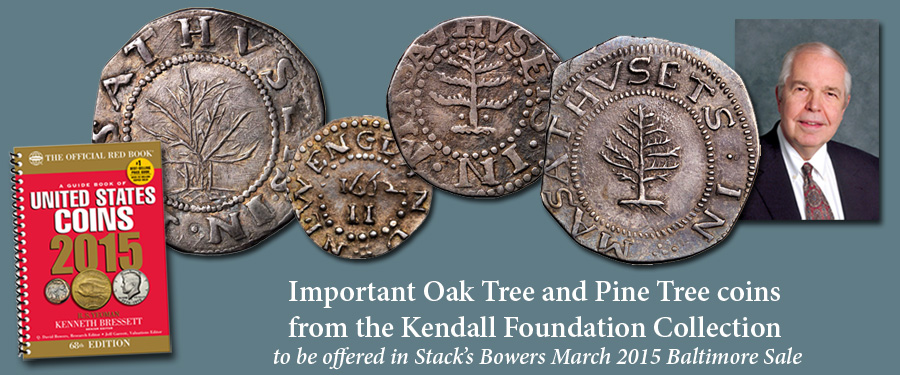
This week I continue my discussion of Massachusetts silver coins. Your at-home text is the 2015 edition of A Guide Book of United States Coins. You can follow my discussion by turning to page 38. Last week I mentioned that in 1652 the Massachusetts General Court authorized coinage for the colony. Up to that time coins in circulation consisted mainly of Spanish-American and European issues. Even more in use were certain commodities with fixed values (cattle, corn and even musket balls) or the barter system.
As related last week, the initial production in Massachusetts was the NE coinage, bearing that notation on one side and a denomination on the other. This was followed by the Willow Tree coinage that took place from about 1653 or 1654, continuing to 1660. Although these pieces are known as Willow Tree issues today, that name was not used numismatically until in a catalog of W. Elliot Woodward in 1867. Now it is standard.
We now move the Oak Tree coinage, which began in 1660 and continued to 1667. The Willow Tree, Oak Tree and, later, Pine Tree pieces, with just one exception (the 1662 Oak Tree twopence) were all dated 1652, this being the year that the coinage was authorized. Unlike the Willow Tree designation, the Oak Tree nomenclature was used by numismatists at an early time. In his 1875 masterwork, The Early Coins of America, Sylvester S. Crosby relates that Sir Thomas Temple, in 1662 when he was discussing the affairs of the Massachusetts Bay Colony, showed King Charles II pieces, which must have been the Oak Tree issues. When the King asked the origin of the design, Temple said it was the Royal Oak in which the King had secreted himself after his troops were defeated at the Battle of Worcester. However, Louis E. Jordan, the scholar referred to last week, the keeper of the numismatic cabinet at Notre Dame University in Indiana, points out that this is more tradition than fact, embellished by later retellings. Whatever the origin, the Oak Tree designation was in use among American collectors in the 19th century. The denominations produced were the threepence, sixpence and shilling. A new denomination, the silver twopence, was introduced in 1662 and bore that particular date, the only such piece to do so in the Massachusetts series. Today, each of the four Oak Tree denominations is readily available in the marketplace, typical grades being VG to VF. Die varieties of these and other Massachusetts coins are customarily attributed to Noe numbers as described by Sydney P. Noe in The New England and Willow Tree Coinage of Massachusetts, 1943, The Oak Tree Coinage of Massachusetts (1947), and The Pine Tree Coinage of Massachusetts (1952), combined together in a reprint, The Silver Coins of Massachusetts (1973). Noe’s studies are based primarily on the cabinet of the American Numismatic Society, New York.
Although the tree on the Oak Tree shilling is not unquestionably an oak – it could be something else – when the Pine Tree design was introduced in 1667, the depiction was without question. This motif follows the tree shown on the flag of the Massachusetts Bay Colony. Pine Tree coinage denominations comprise the threepence, sixpence and shilling. The shillings were made in two formats — the earlier style with large planchet (until about 1675) and the smaller size (thicker and on a narrower diameter planchet, in use until the end of production in 1682). The number of examples existing today suggests that the Small Planchet Pine Tree shillings may have been made in the largest quantities of any of the silver Massachusetts coinage. Michael J. Hodder, a student of the series and cataloger of the incredible collection of Massachusetts silver we sold in the John J. Ford, Jr. Collection, suggests that certain coinages may have overlapped slightly, such as the Oak Tree and Pine Tree issues. The date the Massachusetts mint closed is not known for certain, but production continued at least through 1682. Crosby cites documents in 1684 in which the mint was mentioned in the past tense. The agreement between the colony and mint master Hull expired in May 1682, suggesting a logical termination. Hull died on October 1, 1683.
Among Massachusetts silver coins an all-time favorite is the 1652 Pine Tree shilling known as variety Noe-1. This is an American classic. Ken Bressett, editor of A Guide Book of United States Coins, has this as his favorite as well, as did the late Louis E. Eliasberg. N-1 is rather plentiful, several hundred exist, and examples are readily found in the marketplace, again in typical grades of Very Good to Very Fine, although higher grades are offered now and then.
See you next week.





